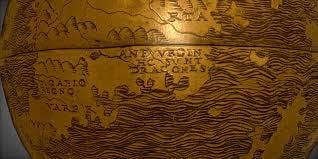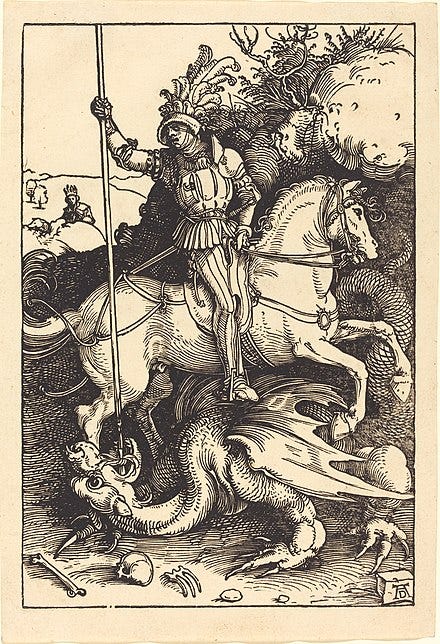On the eastern hemisphere of a 500 year old globe are inscribed these latin words:
“Hic sunt dracones.”
In English, "here are dragons,” or “here be dragons.” Surely a relic from another time, the Hunt-Lenox globe, picture above, represents a premodern, unscientific way of viewing the world. On the edge of what was known, men filled the world in with dark, dangerous creatures. The world was almost mythical then, at least to us now in 2024. Of course, we know now, there are no such things as dragons, monsters, or magical creatures.
Dragons go back from before just 500 years ago. They seem to be one of the oldest mythical images/symbols in human history. What’s extremely interesting is that they seem to be everywhere, as well. While the myriad of different cultures and religions all had different moral systems, governments, foundation narratives, and mythologies, one of the few images to be held by most every single of them is, of course, the dragon.

For some reason, across almost all cultures, times, and places there persists the “Dragon-slaying myth,” the classic tale in which a hero goes to defeat the great symbol of evil and chaos in the world. He may save a damsel in distress. He may have some kind of power or magical sword with him. The dragon may hoard gold. It may breathe fire, or fly. It may have wings, or it may come up from the depths of the primordial abyss. It may give riddles or make the hero pass tests. In all its forms, though, the bare bones are the same: hero faces dragon, hero saves world. There is something potent about this story, this image, of a lowly human daring to face off against something so uncontrollable, so immense and powerful, so dangerous, so ancient and evil, as a dragon.
Yet, what we might dismiss as fantasy from an uneducated, superstitious age has only persisted in our cultural mind and the stories we tell. Dragons, it seems, have gone nowhere. They still exist, if only in the minds of writers, amongst the pages of epic novels, in glorious boss battles in video games, and on the screens of the latest fantasy movies/tv shows. Dragons still capture the imagination of the masses and serve as a powerful symbol in the stories we tell.
While some may not know this (this is where we’ll begin to find out who the Bible nerds are), the Hebrew and Christian Bible is full of dragons. I don’t have time to get into the details of a biblical theology of dragons (how cool is that?…Yes I’m one of the Bible nerds), and so I will point you to by far the best, most beautiful, and most accessible resource I know on the subject: BibleProject. You’re welcome. Go watch that and, please, come back. Their podcast series is also really, really great.
The image of a primordial serpent as a symbol for evil and chaos in the world was not one that was foreign to the ancient writers of the Scriptures. The devil, the adversary, is depicted often in this way. He is most famously a serpent in the Garden of Eden and in the book of Revelation. Both are instructive for our purposes here.
The Bible depicts the serpent in the way most ancient cultures do: a force of evil that intends to wreak havoc and bring chaos into the world that God has ordered to be good and beautiful. The image of the dragon in the Scriptures is one of a being that is opposed to God’s good intentions for his creation and his children.
In the biblical narrative, the dragon, Satan, is to be defeated by a coming chosen-one. As Genesis 3:15 famously puts it:
And I will put enmity
between you and the woman,
and between your offspring and hers;
he will crush your head,
and you will strike his heel.”Genesis 3:15 NIV
YHWH God is here speaking to the snake, telling him that one day one will come that will destroy him by crushing his head. This is the beginning of the biblical mosaic of the Messiah figure - the promised King who will come and defeat that adversary of God’s people and put things right.
This is where Revelation comes in. Jesus comes in the beginning of the New Testament claiming to be both this Messiah figure who would crush the serpent’s head and to also surprisingly be YHWH God himself, embodied and incarnated, to do for humanity what they could not do for themselves. He dies on the cross, and rises again three days later - this is the beginning of his new kingdom reality in which God is bringing us back to his Garden reality (or more bringing the Garden Kingdom to us!). Revelation depicts Jesus as victorious over the dragon finally and fully at his future final return when he will consummate his kingdom and make all things new.
“The great dragon was hurled down—that ancient serpent called the devil, or Satan, who leads the whole world astray. He was hurled to the earth, and his angels with him. Then I heard a loud voice in heaven say:
‘Now have come the salvation and the power
and the kingdom of our God,
and the authority of his Messiah.’”Revelation 12:9-10 NIV
Jesus is the hero of the dragon myth, come to destroy its evil and recreate the world anew.
Here’s one of the things that’s surprising about the biblical version of the dragon slaying myth. Jesus is certainly the hero who defeats the dragon - it is not something we can do, it is something he does for us. Yet, the Scriptures tell us that in his defeat of the dragon, sin, and death, that we are given new life and new power by Jesus’s Spirit, the very Spirit of the living God that raised Jesus from the dead (Romans 8). We are therefore, not simply passive consumers, but reborn into active participants in Jesus’s crushing of the serpent’s heads, given a job to do and a war to fight .
Here’s a few verses to show you what I mean:
“In all these things we are more than conquerors through him who loved us.”
Romans 8:37 NIV
Because of Jesus, we are made into conquerors of sin and death, both of which are brought into the world by the dragon.
“Put on the whole armor of God, that you may be able to stand against the schemes of the devil.”
Ephesians 6:11 ESV
We must put on armor, given to us by God, in order to stand against the devil.
“Little children, you are from God and have overcome them, for he who is in you is greater than he who is in the world.”
1 John 4:4 ESV
And
“Be sober-minded; be watchful. Your adversary the devil prowls around like a roaring lion, seeking someone to devour. Resist him, firm in your faith, knowing that the same kinds of suffering are being experienced by your brotherhood throughout the world.”
1 Peter 5:8-9 ESV
The devil, while defeated by Jesus in his death and resurrection, is still our adversary as followers of Jesus. He is defeated and he is dying - but he is still dangerous, and Jesus will return one day to finalize what happened on Calvary. In the meantime, as the verses above show, we are called to put on our armor, stand our ground, and fight back against the devil who schemes against us. But, we are not left unable to fight - Jesus’s victory has allowed us to stomp on the devil’s head just as Jesus did. In Jesus, the ultimate Snake-Crusher, we too are empowered and trained to slay dragons.
“The God of peace will soon crush Satan under your feet.”
Romans 16:20 ESV
Yet, it must be acknowledged: we exist in what biblical scholars call the now-and-the-not-yet: Jesus’s kingdom is inaugurated but not consummated. In World War II, D-Day was the the day the war was won and victory of the Axis Powers was ensure. Yet, there was a time after in which there were more battles to be fought until V-Day, in which the war officially ended and the Axis Powers acknowledged defeat. We exist in between D-Day and V-Day; our enemy is defeated, but there is time yet before the fullness of that victory is realized.
In the meantime we are given the Holy Spirit of Jesus to fight back in his Name and in his power, as part of his body, the Church. This Substack is about that - the meantime. What we are supposed to do in the now-and-the-not-yet. How are we to follow Jesus in our cultural moment? How are we to resist the devil and crush that crafty serpent's head in all his manifestations? How are we to pursue the Good, the True, & the Beautiful?
It is here that the goal of this Substack is laid bare: We are here to learn how to slay dragons and crush serpents. Jesus has made us conquerors, given us power over sin, death, and evil. He has inaugurated his kingdom in which we are set free from the power of the snake and imbued with his resurrection life and power.
There is yet another cultural expression of the dragon myth, this one in the grand tradition of the Church - that of St. George.
This is the symbol and image of this Substack for what St. George represents - the Christian fighting back against the enemy and evil in the world. St. George is our patron saint, if you will, beckoning us to take up our cross and follow Jesus, to live out the victory Jesus won for us and crush the head of the serpent. We will learn to live well in the tension of the now-and-the-not-yet. We will be trained in the art of dragon slaying. We will learn to live out the life Jesus bought for us and made accessible to us by his resurrection and his Spirit.
Join me in this Substack as we explore how to slay dragons in Jesus name and take hold of the life he’s given us in this cultural moment through conversations on such topics around theology and biblical studies, philosophy and history, culture and story, and much more.
Hic sunt dracones.






Well written Chase! I love that you are both a Christ lover and a history nerd!